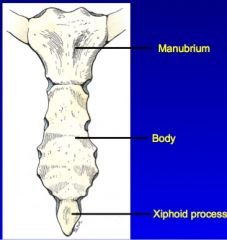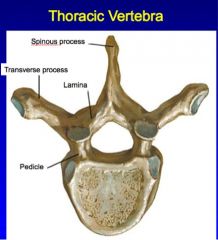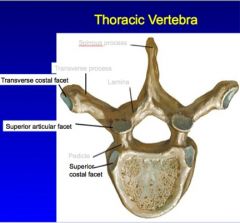![]()
![]()
![]()
Use LEFT and RIGHT arrow keys to navigate between flashcards;
Use UP and DOWN arrow keys to flip the card;
H to show hint;
A reads text to speech;
12 Cards in this Set
- Front
- Back
|
This area of the thorax is demarcated by the 1st pair of ribs that come in and articulate (via cartilage) to the anterior portion of the sternum. There are very important structures that will be coming in and out of this region. |
Superior Thoracic Aperture
|
|
|
This area of the thorax is anteriorly demarcated by the costal arch (made up of two ____________, which is itself costal cartilage). Posteriorly this area is demarcated by the 12th rib and the T12 vertebrae.
|
costal margins, Inferior Thoracic Aperture.
|
|
|
Name the three parts of the sternum and a particularly important area of the sternum that has a lot of anatomical and clinical relevance.
|

Sternal angle of Louis is between manubrium and body. CLINICALLY: Very important landmark because you can find the second intercostal space adjacent to this. Certain sounds are found at certain intercostal spaces. (More about this tomorrow with the heart.)
ANATOMICALLY: You can find the aortic arch, this is where your trachea bifurcates too. If you take a plane on thru the sternal angle and look at where it comes out posteriorly, that is about thoracic vertebrae 4 and 5 (not T1-2!). |
|
|
What is the importance of the Sternal Angle (of Louis)?
|
CLINICALLY: Very important landmark because you can find the second intercostal space adjacent to this. Certain sounds are found at certain intercostal spaces. (More about this tomorrow with the heart.)
ANATOMICALLY: You can find the aortic arch, this is where your trachea bifurcates too. If you take a plane on thru the sternal angle and look at where it comes out posteriorly, that is about thoracic vertebrae 4 and 5 (not T1-2!). |
|
|
If you take a plane on thru the sternal angle and look at where it comes out posteriorly, at what level vertebrae does it come out?
|
T4-T5
|
|
|
Regarding ribs:
A. how many does each person have? B. Which are the true ribs and what makes a rib a true rib? C. Same as B but for false ribs. D. What is a further subdivision of false ribs and which ribs belong to that category? |
A. 12 ribs
B. pairs 1-7 are true. These articulate onto the sternum via the costal cartilages. C. pairs 8-12 are false. These make an even more indirect articulation with the sternum via costal margin's costal cartilage OR do not articulate with sternum at all (floaters). D. Floaters, 11 and 12. Do not articulate with sternum at all. |
|
|
Another way to classify the 12 ribs besides the true/false/floating categories is.... Which ribs belong to each category?
|
Typical: ribs 3-9
(has 1 head with 2 facets, neck, tubercle, body, costal angle, costal groove) Atypical: ribs 1,2, 10-12 (is missing some of the above, or is just different) |
|
|
Which ribs are typical? What are the characteristics of a TYPICAL rib?
|
Ribs 3-9 are typical. Has a “head” (which is posterior aka connects to vertebral column) with two facets (articular facets of head of the rib). Has a neck (region between head and tubercle region). Has a tubercle (which is kind of interrupted by the articular facet of tubercle). Has a body. Has a costal angle (as rib turns sharply). Has a costal groove (inferior aspect of rib where neurovascular bundles run).
|
|
|
What is the inferior aspect of the rib where neurovascular bundles run called?
|
The costal groove.
|
|
|
How are intercostal spaces named? What is the exception? What are the two particularly important interostal spaces Dr. Dupree mentioned and why are they important?
|
The space below the rib is that number's intercostal space. There are 11 intercostal spaces and 1 subcostal space.
2nd intercostal space: Right side is the aortic valve and Left side is the pulmonary valve. 5th intercostal space: Left side the apex of the heart is palpable! |
|

|

|
|

Name these points of articulation and differentiate between them.
|

(Superior/ Inferior / Transverse) Costal facet: rib involved in articulation!
(Superior / Inferior ) Articular facet: allow adjacent vertebrae to come together |

